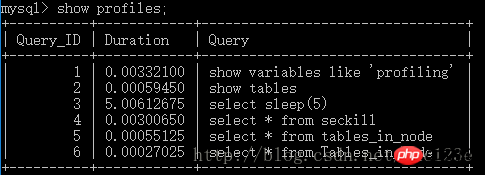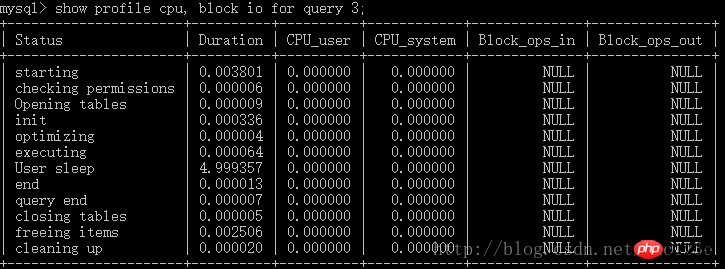Use MySQL to analyze SQL time-consuming issues
Slow log query
MySQL's slow log query is a log record provided by MySQL. It records statements whose response time exceeds the threshold in MySql. Specifically, SQL that takes longer than the long_query_time value will be recorded in the slow log. The default time of long_query_time is 10, which means running more than 10 statements.
For example, if a SQL statement takes more than 5 seconds to execute, even if it is a slow SQL statement, MySQL will record the SQL statement that exceeds 5 seconds. We can conduct a comprehensive analysis in conjunction with explain.
By default, the MySQL database does not enable slow query logs, and we need to set this parameter manually. Of course, if it is not required for tuning, it is generally not recommended to enable this parameter, because slow logging will more or less have a certain performance impact.
Whether it is enabled and set
#查看是否开启show variables like '%slow_query_log%';#开启set global slow_query_log = 1;
Using set global slow_query_log=1 to enable the slow query log will only take effect on the current database and will become invalid if MySQL is restarted. If you want it to take effect permanently, you must modify the configuration file my.cnf.
Note that after setting the slow query threshold time, you may not see the value change, that is, it does not take effect. In this case, you need to reconnect or open a new session to see the modified value.
show variables like '%long_query_time%'
Or you can use the following command without reopening the connection:
show variables like '%long_query_time%'
Which sql will be recorded by slow log, which is controlled by long_query_time. By default, the value of long_query_time is 10 seconds. , command:
show variables like '%long_query_time%';
If the running time is exactly equal to long_query_time, it will not be recorded. In other words, in mysql, it is judged to be greater than long_query_time, not greater than or equal to.
You can use the following statement to do a test
SELECT sleep(4)
If you set long_query_time to 3 seconds, then this statement will be recorded.

View the number of slow logs
show global status like '%slow_queries%'
Log analysis tool mysqldumpslow
In the production environment, if you want to manually analyze the log, find, Analyzing SQL is obviously a laborious task. MySql provides the log analysis tool mysqldumpslow.
For example:
#得到返回记录集最多的10个SQL Mysqldumpslow –s r –t 10 D:\Program Files\mysql\data\DESKTOP-VN2D5OU-slow.log#得到访问次数最多的10个SQL Mysqldumpslow –s c –t 10 D:\Program Files\mysql\data\DESKTOP-VN2D5OU-slow.log#得到按照时间排序的前10条里面含有左连接的查询 Mysqldumpslow –s t –t 10 –g “left join” D:\Program Files\mysql\data\DESKTOP-VN2D5OU-slow.log#另外建议在使用这些命令时结合|和more使用,否则可能出现爆破情况 Mysqldumpslow –s r –t 10 D:\Program Files\mysql\data\DESKTOP-VN2D5OU-slow.log|more
参数含义 s: 表示按照何种方式排序 c:访问次数 l:锁定时间 r:返回记录 t:查询时间 al:平均锁定时间 t:返回前面多少条的数据 g:后面搭配一个正则表达式
Use show profile for sql analysis
The show profile command can analyze the resource consumption of statement execution in the current session. Used to find SQL time-consuming bottlenecks. It is turned off by default and saves the results of the last 15 runs.
Check whether it is turned on (show variables like ‘profiling’;)
Turn on the function (set profiling = on;)
After turning it on, you can record the subsequent running of sql. Then use show profiles to view the results:

Further analyze the execution of a certain SQL statement through the command (show profile cpu, block io for query 3;), for example, the following analysis 3 No. SQL situation.

Some parameters behind Show profile:
All: Display all overhead information
-
Block io: Display block IO related overhead
Context switches: Context switch related overhead
Cpu: Display cpu related overhead
Memory: Display memory-related overhead
Source: Display overhead information related to source_function, source_file, source_line
Global query log
(Never turn it on in a production environment to view all executed SQL statements)
Set command:
set global general_log = 1;#以表的形式输出set global log_output = ‘TABLE’
After that, the SQL executed by mysql The statement will be recorded to the mysql.genearl_log table, which can be viewed with the following command:
select * from mysql.general_log;
It can also be configured in the configuration file and set as follows:
#开启General_log = 1#记录日志文件的路径General_log_file = D://path/logfile#输出格式Log_output=file
The above is the detailed content of Use MySQL to analyze SQL time-consuming issues. For more information, please follow other related articles on the PHP Chinese website!

Hot AI Tools

Undresser.AI Undress
AI-powered app for creating realistic nude photos

AI Clothes Remover
Online AI tool for removing clothes from photos.

Undress AI Tool
Undress images for free

Clothoff.io
AI clothes remover

Video Face Swap
Swap faces in any video effortlessly with our completely free AI face swap tool!

Hot Article

Hot Tools

Notepad++7.3.1
Easy-to-use and free code editor

SublimeText3 Chinese version
Chinese version, very easy to use

Zend Studio 13.0.1
Powerful PHP integrated development environment

Dreamweaver CS6
Visual web development tools

SublimeText3 Mac version
God-level code editing software (SublimeText3)

Hot Topics
 MySQL's Role: Databases in Web Applications
Apr 17, 2025 am 12:23 AM
MySQL's Role: Databases in Web Applications
Apr 17, 2025 am 12:23 AM
The main role of MySQL in web applications is to store and manage data. 1.MySQL efficiently processes user information, product catalogs, transaction records and other data. 2. Through SQL query, developers can extract information from the database to generate dynamic content. 3.MySQL works based on the client-server model to ensure acceptable query speed.
 How to start mysql by docker
Apr 15, 2025 pm 12:09 PM
How to start mysql by docker
Apr 15, 2025 pm 12:09 PM
The process of starting MySQL in Docker consists of the following steps: Pull the MySQL image to create and start the container, set the root user password, and map the port verification connection Create the database and the user grants all permissions to the database
 Laravel Introduction Example
Apr 18, 2025 pm 12:45 PM
Laravel Introduction Example
Apr 18, 2025 pm 12:45 PM
Laravel is a PHP framework for easy building of web applications. It provides a range of powerful features including: Installation: Install the Laravel CLI globally with Composer and create applications in the project directory. Routing: Define the relationship between the URL and the handler in routes/web.php. View: Create a view in resources/views to render the application's interface. Database Integration: Provides out-of-the-box integration with databases such as MySQL and uses migration to create and modify tables. Model and Controller: The model represents the database entity and the controller processes HTTP requests.
 Solve database connection problem: a practical case of using minii/db library
Apr 18, 2025 am 07:09 AM
Solve database connection problem: a practical case of using minii/db library
Apr 18, 2025 am 07:09 AM
I encountered a tricky problem when developing a small application: the need to quickly integrate a lightweight database operation library. After trying multiple libraries, I found that they either have too much functionality or are not very compatible. Eventually, I found minii/db, a simplified version based on Yii2 that solved my problem perfectly.
 How to install mysql in centos7
Apr 14, 2025 pm 08:30 PM
How to install mysql in centos7
Apr 14, 2025 pm 08:30 PM
The key to installing MySQL elegantly is to add the official MySQL repository. The specific steps are as follows: Download the MySQL official GPG key to prevent phishing attacks. Add MySQL repository file: rpm -Uvh https://dev.mysql.com/get/mysql80-community-release-el7-3.noarch.rpm Update yum repository cache: yum update installation MySQL: yum install mysql-server startup MySQL service: systemctl start mysqld set up booting
 Laravel framework installation method
Apr 18, 2025 pm 12:54 PM
Laravel framework installation method
Apr 18, 2025 pm 12:54 PM
Article summary: This article provides detailed step-by-step instructions to guide readers on how to easily install the Laravel framework. Laravel is a powerful PHP framework that speeds up the development process of web applications. This tutorial covers the installation process from system requirements to configuring databases and setting up routing. By following these steps, readers can quickly and efficiently lay a solid foundation for their Laravel project.
 MySQL and phpMyAdmin: Core Features and Functions
Apr 22, 2025 am 12:12 AM
MySQL and phpMyAdmin: Core Features and Functions
Apr 22, 2025 am 12:12 AM
MySQL and phpMyAdmin are powerful database management tools. 1) MySQL is used to create databases and tables, and to execute DML and SQL queries. 2) phpMyAdmin provides an intuitive interface for database management, table structure management, data operations and user permission management.
 Centos install mysql
Apr 14, 2025 pm 08:09 PM
Centos install mysql
Apr 14, 2025 pm 08:09 PM
Installing MySQL on CentOS involves the following steps: Adding the appropriate MySQL yum source. Execute the yum install mysql-server command to install the MySQL server. Use the mysql_secure_installation command to make security settings, such as setting the root user password. Customize the MySQL configuration file as needed. Tune MySQL parameters and optimize databases for performance.






